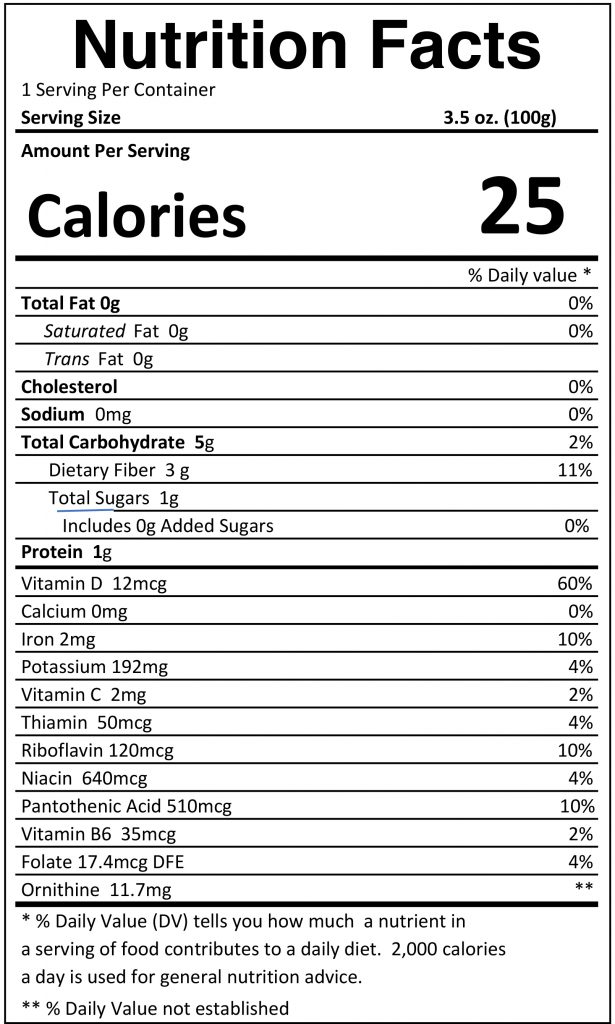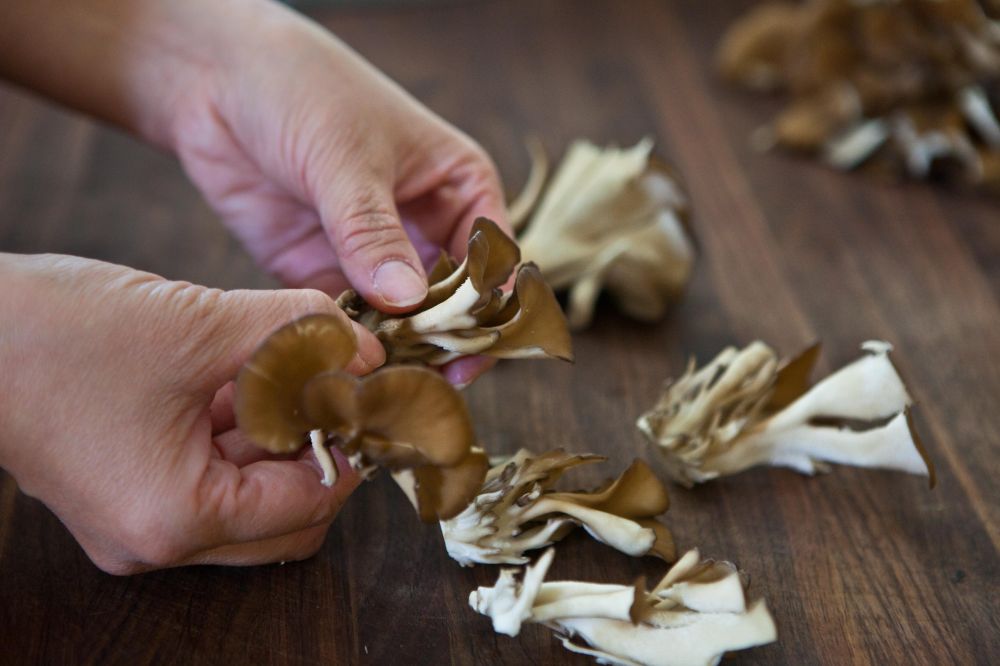Maitake Offers a Significant Source of Vitamin D, Niacin and Dietary Fiber
Maitake offers a significant source of Vitamin D (60% RDV), Dietary fiber (11% RDV), Iron (10% RDV) and Pantothenic Acid (10% RDV). It is a key ingredient for the savory, rich flavor known as the fifth taste, “Umami”. It is also cholesterol and sodium free in addition to low in calories.

High in
- Vitamin D
12.5mcg
- Iron
2mg - Dietary Fiber
3g
- Pantothenic Acid
510 mcg
Low in
- Cholesterol
0mg
- Sodium
0mg
- Fat
0g
* RDV – the recommended daily value based on a 2,000-calorie diet. / Serving size: 3.5 oz (100g)
Many researchers have been noted of Maitake health benefits as used in Asian medicine to enhance the immune system. Maitake is also rich in antioxidants which have been known to help prevent or fight cancer.
Other Nutrients & What are they?
| Vitamin B6 | 35 mcg | 2% RDV | Vitamin C | 2mg | 2% RDV | |
| Thiamin | 50mcg | 4% RDV | Ribofavin | 0.12mg | 10% RDV | |
| Potassium | 193mg | 4% RDV | Niacin | 0.64mg | 4% RDV | |
| Folate | 17mg | 4% RDV | ||||
Mushrooms are the only produce that contains Vitamin D.
According to The National Institutes of Health (NIH), Vitamin D is a nutrient important for promoting overall health and is especially important in developing and maintaining strong bones.



Taste / Flavor
Maitake has a firm texture and robust, earthy flavor. In Japanese, Maitake means “dancing mushroom.” Some believe that, in ancient times, people danced for joy upon finding these mushrooms, which were worth their weight in gold. Others say that name derives from the mushroom’s shape, which resembles a dancing nymph.
It is a good source of protein and is an essential ingredient for the flavor known as “umami”, a unique, savory flavor, that makes Maitake a good meat substitute.
Hokto’s Kinoko is Clean and Ready-to-Cook
Maitake can be eaten in clusters or separated. They are clean and ready-to-cook. Hokto’s Kinoko does not need to be washed or rinsed because they are cultivated in a soil-free and clean environment and are 100% USDA Organic! To get the most out of Hokto’s kinoko, always cook them before consuming. Our kinoko should not be served raw.
Why Hokto Kinoko is good for you
How to Prepare Maitake
No Base equals no preparation
Like the Eryngii, Maitake does not have a base. Do not wash Maitake mushrooms because it will reduce flavor. To save on prep time and improve the taste of your dishes, serve Maitake mushrooms as soon as possible after purchase.
Separate by hand to increase flavor
When you separate Maitake by hand, the textured surface of the mushroom will absorb more flavors. Some black liquid from the mushroom may be present, it is polyphenol, which is very nutritious and should be eaten. If you are concerned about the color of polyphenol, boil the mushrooms briefly to eliminate the black liquid. We do not recommend removing the black liquid.
No Mess
Maitake can be separated by hand, thus illuminating the need for a knife and cutting board. Because they are ready to cook, there is no mess to clean up.
Choose Thick, Big Caps
The best Maitake have thick, big caps. Hokto's Maitake have a rich, velvety texture with umami in every bite.
Maitake Recipes
Frequently Asked Questions
Q.Should I cut off the base of Maitake mushrooms?
A.
Like the King Trumpet, there is no base. The bottom parts of Maitake mushrooms are edible, but if you don’t want to eat the base, you can cut them off.
Q.My Eggs or meatloaf did not solidify when I used Maitake.
A.
Maitake mushrooms have Proteolytic enzymes that prevent protein, such as eggs and meat, from solidifying. If you want your dish to solidify when cooking with Maitake, you should boil the mushroom for at least 30 seconds before adding it to your dish. On the other hand, one advantage of adding Mitake directly into your dish, is that it can help tough meat become tender.
Q.What are the white sponge like parts under the Maitake caps?
A.
Under the caps of Maitake is a part called the gill. The gills of the mushroom produce spores as it readies its self for reproduction. As the the mushroom grows the spores become more visible. These spores may be more visible but they do not effect the mushroom and are edible.
Q.There is a brown ring on the bottom of the mushroom.
A.
This is a ring mark from the cultivation base and is edible. If you do not like the look or texture you can cut the ring off.
Q.What is the black liquid? Is it safe?
A.
Maitake mushrooms have a natural black pigment to them, thus making the liquid they produce black as well. It is not scum; it contains nutritious ingredients beneficial to health, like polyphenol. To get the most nutrition out of the mushroom, do not discard the liquid. One helpful suggestion is to use Maitake mushrooms in soups for creating a highly nutritious broth.
Research
As part of missions, our mushroom research center is dedicated to scientificaly unraveling the beneficial pharmacological effects of mushrooms in order to put them to use in promoting and maintaining healthy lifestyles.








